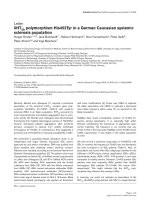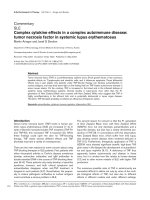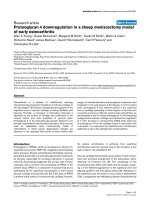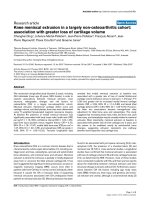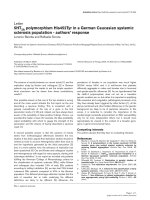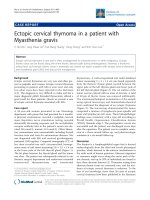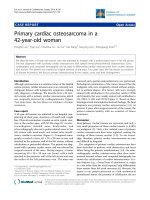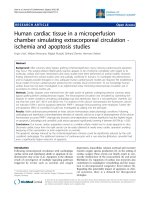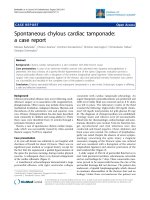Báo cáo y học: " Low Spigelian hernia in a 6-year-old boy presenting as an incarcerated inguinal hernia: a case report" pps
Bạn đang xem bản rút gọn của tài liệu. Xem và tải ngay bản đầy đủ của tài liệu tại đây (461.91 KB, 3 trang )
BioMed Central
Page 1 of 3
(page number not for citation purposes)
Journal of Medical Case Reports
Open Access
Case report
Low Spigelian hernia in a 6-year-old boy presenting as an
incarcerated inguinal hernia: a case report
Efstratios Christianakis
1
, Nikolaos Paschalidis
2
, Georgios Filippou
2
,
Spiros Rizos
2
, Dimitrios Smailis
2
and Dimitrios Filippou*
2,3
Address:
1
Department of Pediatric Surgery, Pendeli Children's Hospital, Palaia Pendeli, Athens, Greece,
2
First Department of Surgery, Piraeus
General Hospital "Tzaneio", Piraeus-Athens, Greece and
3
Department of Anatomy, Histology and Embryology, Nursing Faculty, University of
Athens, Galatsi-Athens, Greece
Email: Efstratios Christianakis - ; Nikolaos Paschalidis - ;
Georgios Filippou - ; Spiros Rizos - ; Dimitrios Smailis - ;
Dimitrios Filippou* -
* Corresponding author
Abstract
Introduction: Lower Spigelian hernia is a very rare entity. The clinical findings are similar to those
of inguinal hernias and in many cases may be misdiagnosed. In the literature, only a few references
to this entity have been reported in children. To the best of our knowledge, this is the first case
report of a lower Spigelian hernia in a child who presented with an acute painful scrotum.
Case presentation: We discuss the case of a 6-year-old Greek boy who presented to our
emergency department complaining of severe pain in the left inguinal area and scrotum. The acute
painful swelling started suddenly, without any obvious cause. The initial diagnosis was incarcerated
inguinal hernia which was reduced with difficulty. Five days later, the patient still experienced mild
pain during palpation and he was operated on. During the operation, a large lower Spigelian hernia
was revealed and reconstructed.
Conclusion: Although Spigelian hernias are rare in children and difficult to diagnose, physicians
should be aware of them and include them in the differential diagnosis.
Introduction
Lower Spigelian hernia is a rare entity in pediatric surgery,
and is often misdiagnosed as an inguinal hernia [1]. Less
than 50 cases have been presented in the literature, and
only half of them occurred in younger children. In most
of these cases, Spigelian hernias are considered congeni-
tal, although there is not enough evidence to support this
suggestion [2,3]. We report a rare case of a lower Spigelian
hernia in a child which presented as an incarcerated
inguinal hernia.
Case presentation
A 6-year-old Greek boy presented with a painful intumes-
cence of the left inguinal area. The child was initially
referred to a general hospital where the physicians sug-
gested that the problem was an incarcerated left inguinal
hernia. The hernia was reduced with difficulty by the local
surgeon and the next day, the child was referred to our
hospital for further evaluation and treatment. In the phys-
ical examination, the left inguinal area appeared normal
without signs of intumescence. The only findings were
Published: 29 January 2009
Journal of Medical Case Reports 2009, 3:34 doi:10.1186/1752-1947-3-34
Received: 19 May 2008
Accepted: 29 January 2009
This article is available from: />© 2009 Christianakis et al; licensee BioMed Central Ltd.
This is an Open Access article distributed under the terms of the Creative Commons Attribution License ( />),
which permits unrestricted use, distribution, and reproduction in any medium, provided the original work is properly cited.
Journal of Medical Case Reports 2009, 3:34 />Page 2 of 3
(page number not for citation purposes)
subcutaneous edema and a hematoma, probably due to
the manipulations for the reduction. During palpation,
the child presented with mild discomfort and pain in the
left testicle without clinical evidence of testicular torsion.
These symptoms persisted for 3 days and finally we
decided to operate on the patient. A lower Spigelian her-
nia was identified during the operation. The hernia sac
was found to penetrate from a small defect (with an esti-
mated diameter of about 1.5 cm) in the Spigelian fascia
within Hesselbach's triangle (Figure 1).
The lower Spigelian hernia orifice is usually located in a
well-defined area. The defect develops as a ring-like open-
ing through the fibers of the transversalis fascia and the
fascia of the transversalis abdominus and internal oblique
abdominus muscles. Spigelian hernias usually present just
lateral to the rectus muscle in the lower left quadrant.
In our patient, the hernia sac was that of a typical Spige-
lian hernia. The orifice diameter was about 1.5 cm, while
the sac extended up to 7 cm surrounded by preperitoneal
fat (Figure 1). The hernia sac contained a small part of the
large omentum which was reduced. Reconstruction of the
hernia was performed with non-absorbable sutures. Eight
years after the operation, the patient remains free of symp-
toms and recurrence.
Discussion
Spigelian hernias occur through a congenital or usually
acquired defect of the Spigelian fascia, lateral to the rectus
muscle sheath [1]. In adults, almost 90% of acquired her-
nias occur within the anterior superior iliac spine and the
umbilicus, while the majority of congenital hernias occur
at the level of the arcuate line (fold of Douglas) [1-3]. Her-
nias that are protruding through the Spigelian fascia
within Hesselbach's triangle, caudally and medially to the
inferior epigastric vessels, are called low or lower Spige-
lian hernias [4]. Direct inguinal hernias can also occur in
this area, although in most of these cases, the hernia's ori-
fice is difficult to identify. This is the reason why many
Spigelian hernias are misdiagnosed and usually consid-
ered as direct inguinal hernias, para-inguinal hernias or
hernias through the conjoined tendon [5,6]. The diagno-
sis is usually made on the basis of the location of the her-
Intra-operative photograph of the hernia showing the opened sacFigure 1
Intra-operative photograph of the hernia showing the opened sac.
Publish with BioMed Central and every
scientist can read your work free of charge
"BioMed Central will be the most significant development for
disseminating the results of biomedical research in our lifetime."
Sir Paul Nurse, Cancer Research UK
Your research papers will be:
available free of charge to the entire biomedical community
peer reviewed and published immediately upon acceptance
cited in PubMed and archived on PubMed Central
yours — you keep the copyright
Submit your manuscript here:
/>BioMedcentral
Journal of Medical Case Reports 2009, 3:34 />Page 3 of 3
(page number not for citation purposes)
nia's orifice. The orifice of the Spigelian hernia is usually
located inside the fibers of the transversalis fascia. The ori-
fice is sharp and rigid in palpation and its diameter ranges
from 2 to 3 cm [2,3,6]. It extends through this defect inter-
stitially or penetrates the entire abdominal wall [7,8]. The
sac of these hernias usually contains preperitoneal fatty
tissue, and rarely omentum or intestine. Some authors
have suggested that, in infants, Spigelian hernias may
coexist with undescended testes.
The small size of the hernia neck may be a possible expla-
nation for the increased incidence of incarceration. The
incidence of incarceration varies significantly between
various series and authors. Some authors have suggested
that Spigelian hernia incarceration is a rare entity while
others have suggested that it is very common with an esti-
mated incidence of approximately 22% [9,10].
The pre-operative diagnosis of lower Spigelian hernias is
difficult, especially in non-incarcerated cases. In most of
the cases, diagnosis cannot be achieved by physical exam-
ination and the hernia can be easily misdiagnosed as con-
genital inguinal hernia. Recent studies have reported that
the use of ultrasound and computed tomography (CT)
may contribute to the pre-operative diagnosis in selected
cases. A CT scan may be useful in the diagnosis of an incar-
cerated Spigelian hernia mainly due to its ability to dem-
onstrate the layers of the anterior abdominal wall [11,12].
Reduction of the content with excision of the sac and clo-
sure of the fascia defect with non-absorbable sutures is the
most common and widely accepted surgical approach,
presenting the lowest recurrence rates [1,3,7]. Recent stud-
ies support the possible role of laparoscopy in the diagno-
sis and treatment of Spigelian hernia in children,
suggesting that it may represent an acceptable therapeutic
alternative [4,5].
Conclusion
Spigelian hernia occurs through a congenital or, more
often, an acquired defect in the Spigelian fascia, lateral to
the rectus muscle sheath. It is very rare in children. The
case that we present is unique because it is probably the
first report of a lower Spigelian hernia presenting as acute
scrotum. No similar cases have been reported in the liter-
ature. The aim of the present case report is to alert the phy-
sician of this rare entity because, although it is difficult to
diagnose pre-operatively, accurate diagnosis and appro-
priate treatment are essential to avoid future recurrences.
Abbreviations
SH: Spigelian hernia; CT: computed tomography.
Competing interests
The authors declare that they have no competing interests.
Authors' contributions
All authors contributed equally to the treatment of the
patient (EC, NP, GF, DS, SR, DF). EC, NP and GF wrote
the draft. SR and DF approved it. GF, DS and DF carried
out the revision.
Consent
Written informed consent was obtained from the patient's
parents for publication of this case report and any accom-
panying images. A copy of the written consent is available
for review by the Editor-in-Chief of this journal.
Acknowledgements
The authors would like to thank Dr Stolkidis Dimitris from Korinthos Gen-
eral Hospital for his support in the treatment of this rare type of inguinal
hernia.
References
1. Komura JL, Yano H, Uchida M, Shina I: Pediatric Spigelian hernia:
reports of three cases. Surg Today 1994, 24:1081-1084.
2. Al-Salem AH: Congenital spigelian hernia and cryptorchidism:
cause or coincidence? Pediatr Surg Int 2000, 16:433-436.
3. White JJ: Concomitant spigelian and inguinal hernias in a
neonate. J Pediatr Surg 2002, 37:659-660.
4. Rodgers BM, McGahren ED, Burns R: Pediatric hernias. In Abdom-
inal Wall Hernias Edited by: Bendavid R, Abrahamson I, Arregui E, et
al. New York: Springer-Verlag; 2001:591-609.
5. Spangen L: Spigelian hernia. In Hernia Edited by: Nyhus LM, Con-
don RE. Philadelphia, PA: Lippincott Co; 1995:381-392.
6. Donnellan WL: Umbilical hernias, Spigelian and other unusual
abdominal hernias. In Abdominal Surgery of Infancy and Childhood
Volume 2. Edited by: Donnellan WL. NY, USA: Harwood Academic
Publishers; 1996:1-7.
7. Iswariah H, Metcalfe M, Morrison CP, Maddern GJ: Facilitation of
open spigelian hernia repair by laparoscopic location of the
hernia defect. Surg Endosc 2003, 17:832.
8. Losanoff J, Richman B, Jones J: Spigelian hernia in a child: case
report and review of the literature. Hernia 2004, 6:191-193.
9. Kirby RM: Strangulated Spigelian hernia. Postgrad Med J 1987,
63:51-52.
10. Spangen L: Spigelian hernia. World J Surg 1989, 13:573-580.
11. Levy G, Nagar H, Blachar A, Ben-Sira L, Kessler A: Preoperative
sonographic diagnosis of incarcerated neonatal Spigelian
hernia containing the testis. Pediatr Radiol 2003, 33:307-409.
12. Toms AP, Dixon AK, Murphy JMP, Jameson NV: Illustrated review
of new imaging techniques in the diagnosis of abdominal wall
hernias. Br J Surg 1999, 86:1243-1249.

